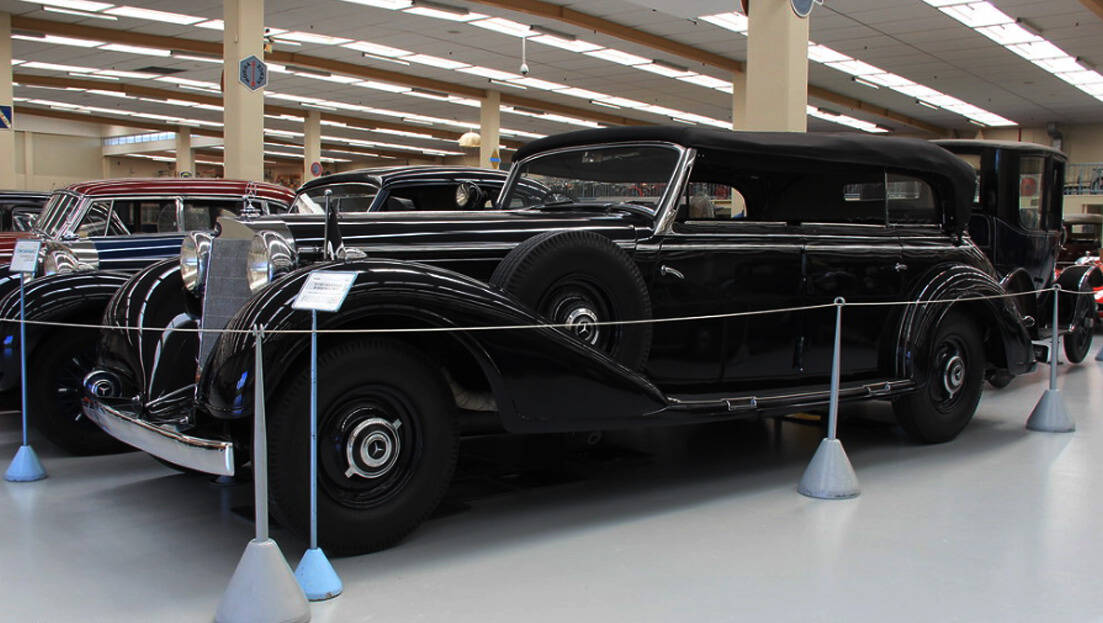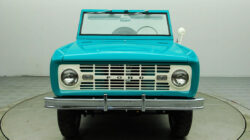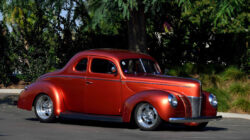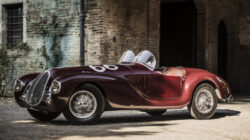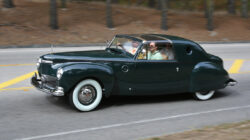The 1940 Mercedes Benz represented a significant turning point in car design with its long, sleek, low-to-the-ground shape that contrasted greatly with cars of the 1940s.
The car was one of the most widely recognized, yet criticized vehicles during its time, and helped spark the genesis of more streamlined designs that followed in years to come.
Let’s take a look at how this unusual vehicle came to be, what made it different from other cars on the road at the time, and why some fans still consider it an iconic piece of automotive history today.
History of the 1940 Mercedes Benz
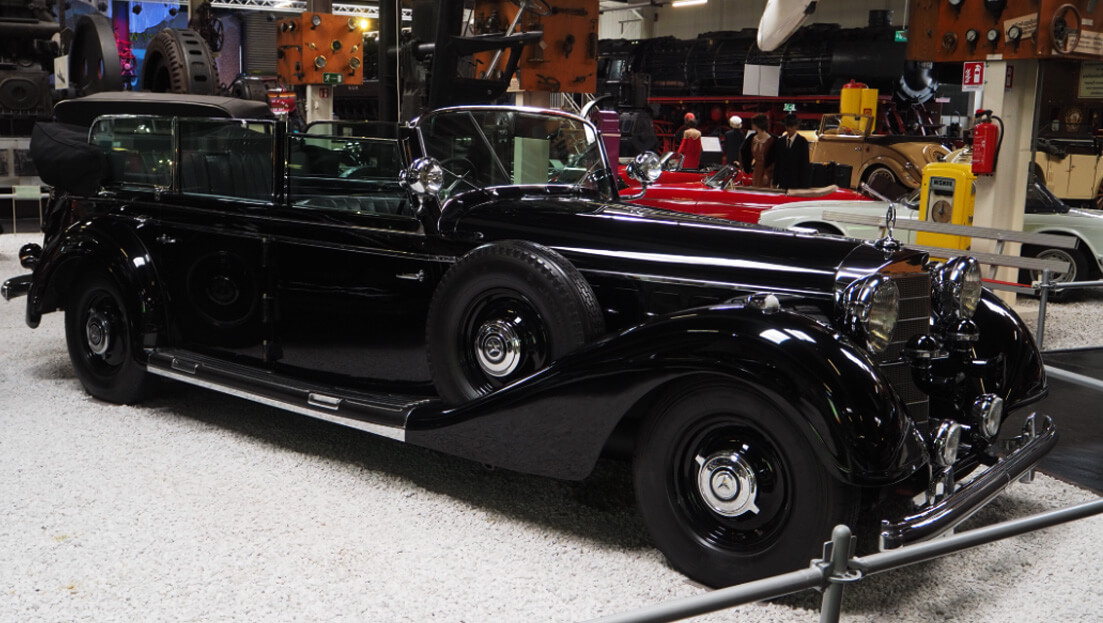
The German company, Daimler-Benz AG (now Daimler AG), was founded as a partnership between Karl Benz and Gottlieb Daimler.
The brand’s original name was DMG, which stood for Daimler Motoren Gesellschaft (Daimler Motor Company). In 1924, it became a limited liability company known as Daimler-Benz.
It built its first automobile in 1889 and sold 5,300 cars by 1910. Meanwhile, another German car company, Mercedes was founded by two brothers named Drefahl in 1872.
They produced their first automobile in 1901 with help from designer Wilhelm Maybach and later turned to Gottlieb Daimler to power their vehicles with his famous engines.
Quick Overview of Some Key Features
The gleaming, streamlined lines of a 1940s Mercedes Benz represented a significant turning point for car design.
The previous decade saw car designs dominated by bulky fenders and hoods that enclosed hulking engines that were neither visually appealing nor well suited to efficiency or speed.
But as engines became sleeker, more aerodynamic, and faster – particularly during World War II when car-makers had very little choice.
But to design cars for speed and efficiency (and not comfort) – owners started to care about how their car looked as much as it functioned.
By changing up existing aesthetics, motorcars could attract more affluent buyers. This is exactly what happened with German manufacturer Daimler-Benz.
Why Was This Car Significant?
The 1940 Mercedes Benz was a big turning point for car design because it represented a significant departure from older cars.
Traditionally, cars from earlier eras had bodies that were boxier with shorter hoods and more upright windshields.
Many of these vehicles still resembled classic horse-drawn carriages, but as technology developed through time, cars became sleeker with longer hoods and lower seats.
The Mercedes Benz was a forerunner to what would become an evolution of newer models to come. This change reflected a progression towards becoming more aerodynamic and faster than ever before.
What’s even more interesting is that one of those new changes would lead to eventual fuel efficiency innovations still used by modern vehicles today!
Changing Times
One notable feature of 1940s classic cars is how low to the ground they were, with some models not much more than 4 feet tall.
The tailfins that swept back from both sides, known as duck tails also gave way to smooth, curvy exteriors that offered a stark contrast from previous decades and changed automobile design.
Prior to Mercedes-Benz designs popularizing them (they ended up inspiring other brands to incorporate fin designs into their vehicles), fins weren’t necessarily a prominent part of vehicle culture; most pre-war models didn’t have them.
Other Factors That Contributed to Its Significance
One of many factors that contributed to its significance is that it was thought to be a great car for tomorrow.
When compared to cars of today, it seems almost alien-like because of its two rear-hinged gullwing doors and streamlined features.
From its exterior, we can see how much car design has changed since the 1940s. However, we must remember that Mercedes still produces cars with these classic styling cues today.
This shows how they adapted rather than conformed to industry trends over time and consistently strived to stay on top of trends (1940s Mercedes Benz).
How the 1940 Mercedes Benz Changed the Shape of Classic Cars
The classic car era began in the early 1900s, but it wasn’t until 1940 that one car really changed the way people looked at classic cars, the Mercedes Benz.
Mercedes has been around since 1901, and they were one of the first luxury manufacturers to put an emphasis on safety with crumple zones and seat belts, but it wasn’t until their Mercedes 1940 model that they really set the precedent for how classic cars look today.
Although the body shape isn’t as different from today’s classic cars as you might think, the advanced technology helped pave the way for how classic cars are designed today.
Development of Streamlined Car Design in the 1930s
The 1930s was a time when car design was shifting dramatically, especially in Europe where flat-nosed cars had become popular.
The futuristic streamlined look emphasized aerodynamics and speed, and would soon be one of America’s trademark car styles.
Though some prototypes were produced as early as 1934, it wasn’t until 1936 that true streamlining techniques came into play.
By 1940, most cars resembled those that made their way to production lines today: low to the ground with smooth, rounded shapes and (usually) four doors.
Daimler-Benz Breakthrough
Although car design in Mercedes 1940 was still dominated by bulky saloons, Daimler-Benz was able to break away from that trend with its creation of an aerodynamic convertible dubbed The Stuttgart Shooting Brake.
Not only did it set a new standard for sleek car design, but it also turned heads wherever it went.
As a result, the large 1940 Mercedes Benz convertible became all the rage throughout Europe and North America. All thanks to one experimental automobile, the 1940 Mercedes coupe (or sedan).
Read more: The Best Classic American Cars 40s and 50s
Streamlining the Sports Car
By 1941, with World War II on the horizon, Mercedes had stopped production of its sleek new design. But when production resumed after WWII ended in 1945, it was clear that the 1940 Mercedes coupe and convertible would be mainstays for decades to come.
By adding tail fins and other aerodynamic updates, and removing much of their chrome, in 1954, Mercedes created what’s now regarded as one of its best designs ever: The Marcedes 300SL Gullwing coupe and roadster.
With these updated iterations, cars were sloping downward at a sharper angle than ever before; they looked almost like they were scuttling along below ground level.
These streamlined sports cars set a new standard for how car designers thought about vehicle design and paved the way for more beautiful models to come.
Keeping Up With New Trends in Automotive Style
The 1940 Mercedes coupe was only one car of many that helped to usher in a new era for cars. As such, it created an aesthetic and engineering style that has lasted through today.
While today’s cars are far different from those produced nearly seventy years ago, it is easy to see some aspects have remained unchanged. For example, one unique aspect of 1940-era vehicles was their compact design.
Today’s BMW 5 Series may be more luxurious than its counterparts from that era but they maintain a similar overall size and length with several other similarities as well.
1940s Mercedes Benz Models – A Complete List
With its innovative use of the automobile and production processes, the German company Mercedes-Benz quickly became one of the largest automakers in the world during the first half of the 20th century.
In this list of 1940s Mercedes Benz models, we’ll take a look at some of the best and most significant automobiles that were manufactured during this decade.
You may be surprised to find out that many of these iconic cars can still be found on the road today, even after all these years!
W136 170V, Mid-size Car (1946–1955)
The Mercedes W136 170V, also known as Typ 170 was a larger-displacement development of Mercedes’ prewar V8, with a new long-nose body and modernized coachwork.
The pushrod eight-cylinder engine displaced 2953 cc and produced 115 hp (86 kW). The car was capable of an impressive 122 mph (196 km/h) in top gear.
It had a wheelbase of 133 in (335 cm), and featured an all-independent suspension, double-wishbone front, with a solid axle on semi-elliptic leaf springs at the rear. This car is considered one of Daimler-Benz’s best models.
W191 170S, Mid-size Executive Car (1949–1955)
The Mercedes W191 170S was a mid-size executive car introduced in 1949 as a successor to an earlier model that had ceased production in 1947.
It was part of a new generation of vehicles for Daimler-Benz and its associated companies, other cars from that era include Mercedes-Benz Typ M130 (sedan), Opel Rekord (sedan), DKW F8, Horch 851, Hanomag Henschel (both a sedan and cabriolet) and Ford Taunus P4.
The 170S sold well on account of its relatively low price in relation to larger models like Type 300 or Type 500/600 but was only produced for five years as there was little demand at its starting price of 4,400 Deutschmarks.
W187 220, Full-size Luxury Car (1951–1955)
From 1951 to 1955, all big Mercedes was powered by an inline-eight-cylinder engine, while smaller models were fitted with inline-four and straight-six engines. This resulted in a distinction between big Mercedes and small ones.
The largest of them was known as Komfortwagen (comfort care), followed by Stromlinienwagen (streamlined car) for medium cars, and Sportsmannswagen (sports car) for two-door sedans.
The smallest models, manufactured only until 1951, were referred to as Kleinlaster or postal delivery vehicles due to their intended use: light commercial vehicle applications such as taxicabs, small buses, or vans for plumbers or electricians.
W186 300, Grand Tourer (1951–1957)
This was essentially a scaled-down version of W198 600. It featured a straight-6 engine of 2.3 or 2.5 liters that produced 115 hp (86 kW).
Acceleration to 60 mph (97 km/h) took just under 10 seconds, with a top speed of around 85 mph (137 km/h).
The four-door saloon had individual seats for five people, and it could reach 130 miles per hour (210 km/h).
An automatic transmission was also available, although rare in the 300s, it wasn’t until 1952 that Mercedes released an automatic transmission car into general production.
W188 300S/300Sc, Luxury Car (1951–1958)
In 1951, a new series of Mercedes 220-C, 220S, and 220SE cars were introduced with a four-cylinder engine of 2.2 liters. The four cylinders had twin spark plugs per cylinder.
The W188 S/SE series also had an upgraded interior with an improved instrument panel, including a speedometer that read up to 120 km/h (75 mph).
At first, all versions came with hydraulic drum brakes, but in 1952 disc brakes were fitted on all 4 wheels.
In 1954 hydraulics were abandoned in favor of a dual circuit braking system using mechanical linkage.
These Mercedes Benz 1940 models were available as saloons and cabriolets in either short or long-wheelbase versions, there was no Stroke Eight offered initially.
W120 180, Mid-size Executive Car (1953–1962)
The Mercedes W120 was introduced in 1953 as a sedan. It was replaced by a new W121 model in 1962, but not before several other body styles were created.
The later models (starting with chassis number 126 300) featured disc brakes on all four wheels, which was very unusual for that time.
Two different engines were offered initially: an OHV inline-6 cylinder 2,200 cc engine delivering 90 hp at 3,600 rpm or 122 lb-ft of torque at 1,800 rpm and a SOHC inline-4 cylinder 1,996 cc engine delivering 86 hp at 4,500 rpm or 113 lb-ft of torque at 2,500rpm.
W180 220a/220S, Luxury Car (1954–1959)
Mercedes 220 sedan, or W180, was introduced in 1954 as a successor to its predecessor. The first model series was named W187. It featured a 2.2-liter engine with dual carburetors and an output of 90 hp (67 kW) at 4,300rpm.
This car featured independent suspension on all four wheels; it could be had with either a manual transmission or automatic transmission.
In 1957, US models received updates to meet new safety standards set by American automotive regulators.
Features included seat belts for outboard seating positions and padded door panels for both front doors along with larger rear side windows for increased visibility behind them.
W198 300SL, Grand Tourer (1954–1963)
The Mercedes 300SL (W198) is a sports car that was manufactured by Mercedes-Benz from 1954 through 1963. Production of 604 2+2 coupes and 75 convertibles totaled 1,400 vehicles.
The W198 featured gull-wing doors and was powered by a fuel-injected 2.0 liter inline four-cylinder engine that produced 162 bhp at 5800 rpm, reaching 60 mph in 8 seconds, with a top speed of 116 mph.
Incidentally, it also featured four-wheel disc brakes (the very first production vehicle to feature disc brakes).
In 1955 Karl Kling traded his 300SL for Juan Manuel Fangio’s winning race car (named La Poderosa).
R121 190SL, Roadster (1955–1963)
The Mercedes R121 190SL was released in 1955 and is an icon of 1950s motoring. The car has a 2.0L straight-6 and has 4 seats with a wheelbase of 112 inches.
The 190SL came standard with dual Solex carburetors, which helped bump output to 115 hp at 5,000 rpm, while top speed improved to 121 mph (195 km/h).
About 3,200 cars were produced before production ended in 1963. These models are highly prized by collectors today for their elegant styling, durability, and performance.
In 1998, Sports Car International placed the R121 190SL at number three on their list of Top Sports Cars of the 1960s.
L319, Light Commercial Van (1955–1968)
Mercedes L319 was based on their W187 chassis. The van had no seats or windows, and a loading platform in the back. The engine was a 3.2 L I6 with an output of 78 hp (58 kW).
As with most postwar German vehicles, they had an electrical generator and dynamo as standard equipment.
This model used Deutsche Fahrzeugfabrik (German vehicle factory) badging, Mercedes-Benz did not resume the use of its name until 1964 after Daimler-Benz purchased all rights to it from its previous owner, Daimler-Benz GmbH.
W105 219, Luxury Car (1956–1959)
With a long wheelbase and distinctive fins, its appearance was reminiscent of a sports car. It came with either a 230 hp (172 kW) 3.0-liter straight-6 engine or a 250 hp (186 kW) supercharged 2.3-liter 4-cylinder M127 engine for its final year.
5,938 units were built between 1956 and 1959. The larger-engined version is known as 220SE to differentiate it from other models with similar body styles.
W121 190, Mid-size Executive Car (1956-1961)
Mercedes W121 190 replaced both models and was available as a sedan or wagon. Available engines were two different versions of Mercedes’ 2.2L 4-cylinder M121 gasoline engine.
A diesel-fueled version of it that generated 60hp, as well as versions of their 2.6L six-cylinder M136 gasoline engine that produced either 116hp or 128hp.
The W121 was also available with four-wheel disc brakes (W111 180S) for an additional price. In 1959 it was succeeded by its successor, the W120 Fintail sedan and wagon series
W189 300d, Full-size Luxury Car (1957–1960)
Mercedes 300d (W189) is a large luxury car produced by Mercedes-Benz from 1957 to 1960. It was available with a straight-six, seven, or eight-cylinder engine.
In North America, its chassis was used as a basis for custom coach-built limousines and hearses for more than twenty years after production ended.
For many years in Brazil, it was considered by some enthusiasts to be a big coupé version of the previous generation of Ponton sedans, mainly due to their very similar appearance but without additional doors.
W128 220SE, Executive Car (1958–1960)
Mercedes W128 220SE, also known as Ponton (pontoon) was Mercedes-Benz’s first post-war production car. Designed by Paul G.
Altmann and Heinrich Nordhoff carried a 2,195 cc inline-four engine with 88 hp (66 kW) at 4500rpm, it had a top speed of 120 km/h (75 mph).
In 1950, it was joined by a coupé variant called 220A and in 1954 by a streamlined 220S model which was often supplied to state officials.
It continued in production until 1957 when it was replaced by a completely new body design W110/W111 180b.
Frequently Asked Questions (FAQ)
What is the oldest model of Mercedes-Benz?
The oldest model of Mercedes-Benz is the 1886 Benz Patent-Motorwagen. This car was designed by Karl Benz and is considered to be the first-ever gasoline-powered car.
The design of this vehicle was quite different from cars of today but laid the foundation for many of the features we now take for granted in modern cars. In the early 1900s.
Mercedes-Benz released a series of luxury cars that were some of the sleekest and most sophisticated models on the market.
These cars were a big contrast to the boxy, bulky cars that were popular at the time. One of the most popular models from this era was the 1940 Mercedes Benz convertible.
This car was known for its style and elegance, and it helped solidify Mercedes-Benz as a luxury car brand.
What Mercedes-Benz was in Jurassic world?
In the film Jurassic World, the Mercedes-Benz G-Class is an SUV that is used by the security team at the Jurassic World theme park on Isla Nublar.
The G-Class is first seen when it arrives at the park to pick up Claire Dearing, Owen Grady, and two other members of the security team.
Later, when the Indominus rex escapes its enclosure, the G-Class is one of the vehicles used in the attempt to contain it. However, the Indominus proves to be too much for the SUV and it is quickly overturned.
Despite this, the G-Class remains an important part of the security team’s arsenal as they continue to try and stop the rampaging dinosaur.
What did Mercedes build in ww2?
Mercedes-Benz was founded in 1926, but its first models didn’t come until the early 1930s. The company built a number of different luxury cars before World War II, including the Type 380 and the Type 500.
But it was the Type 540K that really put Mercedes on the map. The 540K was a sleek, low-to-the-ground car with a long hood and curved fenders.
It was unlike anything else on the road at the time, and it quickly became one of the most sought-after cars in the world.
Mercedes continued to build luxury cars during the war years, including a number of convertibles. But with production halted by Allied bombing raids, only a handful of these cars were ever built.
Was the first car a Benz?
No, the first car was not a Benz. It was created by Karl Benz in 1886. However, the first mass-produced car was the Model T, which was created by Henry Ford in 1908.
The 1940 Mercedes Benz models were a significant turning point in car design. They featured a long, sleek, low-to-the-ground shape that contrasted greatly with cars of the 1940s.
In addition, the Mercedes Benz convertible was introduced in 1940. This model allowed for more open-air driving and became one of the most popular models of the time.
What was Mercedes originally called?
Daimler-Benz AG, commonly referred to as Mercedes-Benz, is a German multinational automotive corporation headquartered in Stuttgart, Baden-Württemberg.
The company was originally founded in 1926 as Daimler-Benz by Wilhelm Maybach and Gottlieb Daimler. In 2018, Daimler AG sold 3.3 million vehicles.
This made Mercedes-Benz the largest seller of premium vehicles in the world.
Conclusion
This list covers nearly every 1940s Mercedes Benz model, from military vehicles to civilian cars. But it’s just a small sample of what was available in 1940.
So for more information about any of these Mercedes Benz 1940 models, or if you have questions about others, be sure to check out our website!
We cover nearly every other vehicle make and model; don’t miss out on great resources like that! Our site will help you figure out what you want to know before going in to speak with an automotive salesman.
And when it comes time to speak with one, we can help you navigate them. As always, we hope your ride is as smooth as possible!
